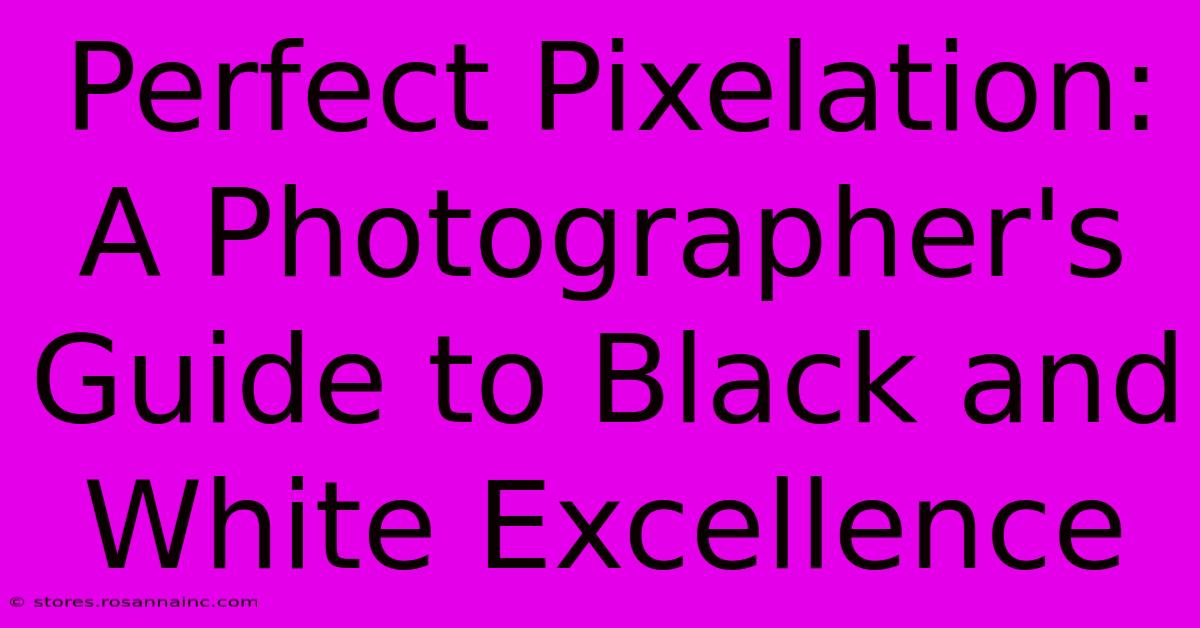Perfect Pixelation: A Photographer's Guide To Black And White Excellence

Table of Contents
Perfect Pixelation: A Photographer's Guide to Black and White Excellence
Black and white photography. It's a timeless art form, stripping away the distractions of color to reveal the essence of light, shadow, texture, and form. But achieving true excellence in monochrome isn't just about converting a color image; it's about mastering a distinct photographic language. This guide will explore the techniques and considerations that will elevate your black and white photography from good to breathtaking.
Seeing in Monochrome: Cultivating Your Eye
Before you even pick up your camera, you need to train your eye to see in black and white. This means learning to appreciate the tonal range – the interplay of light and dark – independent of color.
Developing Your Monochromatic Vision:
- Squint: Squinting your eyes helps desaturate the image, allowing you to focus on the value structure. Practice this while looking at your subject before shooting.
- Convert in-camera: Many cameras allow for shooting directly in monochrome. This forces you to consider composition and tonal values from the outset.
- Study the Masters: Immerse yourself in the works of renowned black and white photographers like Ansel Adams, Dorothea Lange, and Henri Cartier-Bresson. Analyze their use of light, shadow, and contrast. What makes their images compelling?
Mastering the Technical Aspects
While artistic vision is paramount, technical proficiency is crucial for achieving perfect pixelation.
Understanding Exposure and Contrast:
- Exposure: Proper exposure is fundamental. Underexposure can lead to muddy shadows, while overexposure can result in washed-out highlights. Mastering your camera's metering modes is essential.
- Contrast: Black and white photography thrives on contrast. Learn to identify and utilize high-contrast scenes (strong light and dark areas) to create dramatic images. Conversely, low-contrast scenes can offer a different kind of beauty, emphasizing subtle tonal shifts.
Choosing the Right Equipment:
While any camera can produce black and white images, some equipment choices can enhance your results:
- Prime lenses: These often offer superior sharpness and contrast compared to zoom lenses.
- Neutral Density (ND) filters: These allow you to control exposure in bright conditions, enabling you to use wider apertures for shallow depth of field.
- Graduated Neutral Density (GND) filters: These are particularly useful for balancing exposure in scenes with a significant difference in brightness between the sky and foreground.
Post-Processing for Perfection
Post-processing is an integral part of black and white photography. It allows you to fine-tune your image, enhancing its impact and expressing your artistic vision.
Software and Techniques:
- Adobe Lightroom: A powerful tool for adjusting exposure, contrast, shadows, highlights, and applying selective edits.
- Adobe Photoshop: Offers more advanced tools for dodging and burning, creating special effects, and detailed retouching.
- Black and white conversions: Experiment with different conversion methods within your chosen software. Some offer advanced algorithms that simulate different film types.
- Local Adjustments: Utilize tools like the adjustment brush and radial filter to make precise tonal adjustments to specific areas of your image.
Beyond the Basics: Creative Exploration
Once you've mastered the fundamentals, explore advanced techniques to push your creative boundaries.
Exploring Textures and Patterns:
Black and white photography excels at highlighting texture and pattern. Look for subjects that showcase these qualities, and use lighting to accentuate them.
Using Light and Shadow Masterfully:
Experiment with different lighting conditions. Harsh midday sun can create strong contrasts, while soft, diffused light produces smoother transitions.
Conclusion: The Journey to Black and White Mastery
Achieving "perfect pixelation" in black and white photography is a journey, not a destination. It requires dedication, practice, and a constant pursuit of improvement. By understanding the principles discussed here and continuously refining your skills, you will be well on your way to creating stunning and evocative monochrome images that resonate with viewers for years to come. So grab your camera, explore the world around you, and unlock the captivating beauty of black and white.

Thank you for visiting our website wich cover about Perfect Pixelation: A Photographer's Guide To Black And White Excellence. We hope the information provided has been useful to you. Feel free to contact us if you have any questions or need further assistance. See you next time and dont miss to bookmark.
Featured Posts
-
Unlock The Secrets Of Lighting Portrait Photography Filter Hacks For Impact
Feb 04, 2025
-
Automate Marketing Magic Mailer Lite Webhook Makes Unsubscribing And Resubscribing A Breeze
Feb 04, 2025
-
Prepare To Be Astounded Perry Homes For Sale With Views That Will Steal Your Breath
Feb 04, 2025
-
Unlock Your Potential Silence Is Not The Answer To Productivity
Feb 04, 2025
-
Unlock The Key To Paradise Perry Homes Near You
Feb 04, 2025
